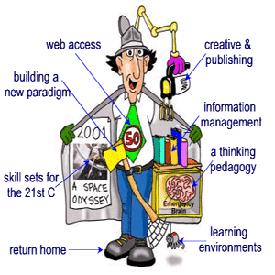Great Ways to Incorporate Technology

Excellent use of technology can enhance your teaching and accelerate
student learning.
(Or not -- don't think about those days when either
you or a student spent forty-five minutes trying to run a power-point
with a laptop and projector, and it never did work.)
Teaching:
- Using your website to make your syllabus, your calendar, and your assignments available digitally
- The usual suspects: films, lyrics from CD's, a computerized slide show or even, once in a while, a truly excellent power point.
For composition teachers:
- Online demonstrations of legitimate websites vs. less dependable websites
- Online demonstrations of how to use web information, graphics, videos, blogs, email, etc. and how to cite those sources
- Use of computer and projector to show steps in the writing process:
- brainstorming
- freewriting
- writing and editing a thesis
- developing a body paragraph
- graceful use of sources
- documenting source material
- doing proper indented quotations
- writing topic sentences that connect to the thesis
Assignments:
- Blogs, websites, podcasts and films as possible 21st century types of writing.
Assign a blog (see one for 1A) - Incorporation of graphics, audio and video (YouTube, etc.) material into "papers" as supporting data.
- Technology issues as topics for analysis, argument, and persuasion.
- Turnitin and Google as tools for teachers and students to avoid plagiarism.
- Comment and other digital paper-response programs as alternatives to handwritten comments on hard copy.
- In-class papers written in the computer lab.
- Research days in the computer lab.
Communication:
- Messages to students before the first day using the Portal
- Class listservs and discussion boards linked to your website for extending discussion past the class period.
- Individual e-mails to students about whom we are concerned
- Class e-mails about emergency absences, clarification of assignments or for reminders.

